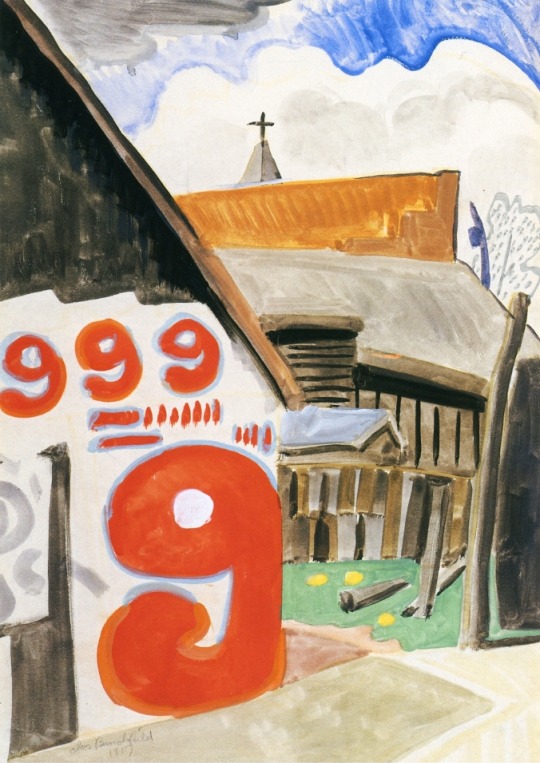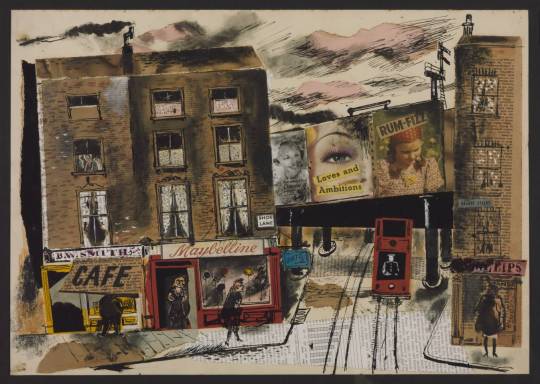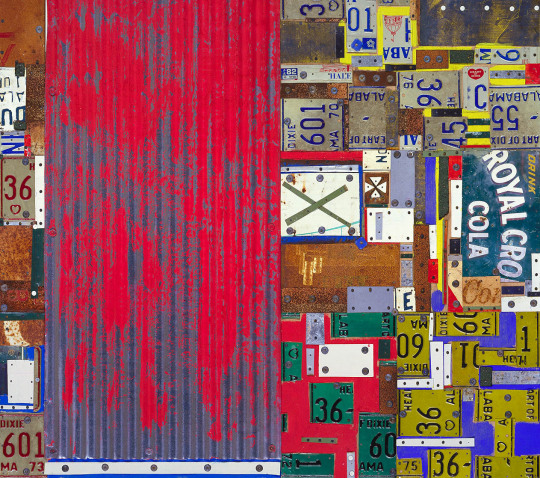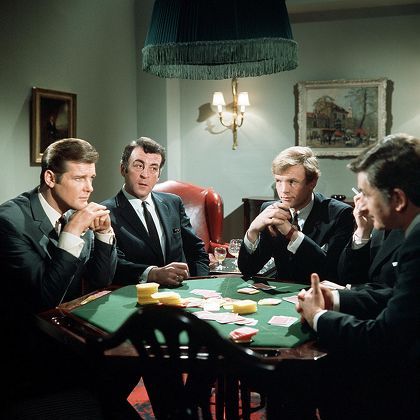#Reginald Marsh
Explore tagged Tumblr posts
Text

The Bowery by Reginald Marsh, 1930. Tempera on masonite.
Marsh’s urban scenes of Depression-era New York highlighted the hobos of the Bowery, where he frequently sketched. Using a brown palette for The Bowery, Marsh painted a crowded scene of down and out men standing along the Bowery, surrounded by signage, and with the Third Avenue elevated railway seen above. In 1929, Thomas Hart Benton introduced Marsh, a colleague and close friend, to the medium of egg tempera, and from 1929 to 1940 tempera became his preferred medium for such major works as The Bowery. Like Benton, Marsh’s rhythmic and often bawdy compositions were influenced by Renaissance and Baroque masters. They were nonetheless deeply rooted in the harsh realities of 1930s America. (Metropolitan Museum of Art)
Photo: Amazon
#vintage New York#1930s#Reginald Marsh#painting#Bowery#Great Depression#homeless#tempera#down & out#despair#social realism
101 notes
·
View notes
Text

“Wonderland Circus, Sideshow Coney Island," by Reginald Marsh, 1930
42 notes
·
View notes
Text

BREAD LINE - NO ONE HAS STARVED, 1932 by REGINALD MARSH
Rather than portray individuals as victims of poverty, MARSH uses the similarly dressed men’s row to portray a collective view of the consequences of the Great Depression. The row extends beyond the etching’s boundaries without indicating a beginning or an end, and this, in conjunction with the absence of space above or below the figures’ heads, symbolizes their social and economic confinement.
The title of this piece is part of a quote taken from President HOOVER, who running for reelection in 1932 stated that the AMERICAN economy was fundamentally sound and that "No one has starved.
At the same time, the fact, however, that many of the men are attempting to pick the pockets of those in front of them in the line also implies an element of gentle satire to the work. . This duality is further emphasized by the similarities between the painting and traditional friezes.
This can either be interpreted as a celebration of the average person by showing them in a traditional way or as a satire comparing the poor working class to the heroes of traditional myths.
This etching, produced at the height of the Depression, shows a line of men waiting for governmental hand-outs of food. The bread line was a common theme in 1930s Social Realism as it demonstrated the tangible effects of the Depression on the working classes.
#bread line#noone has starved#reginald marsh#great depression#realism#realism painting#realist painting#realist painter#realist
11 notes
·
View notes
Text

Reginald Marsh - Merry Go Round Girl
24 notes
·
View notes
Text










Notable examples of text in art, episode 22.
Featuring:
Reginald Marsh, Tattoo and Haircut, 1932, egg tempera on masonite, 46x48 in Joan Brown, The Journey #1, 1976 Mark Bradford, Rat Catcher of Hamelin III, 2011, mixed media on canvas, 120x126in Aboudia, Quitte le pouvoir, 2011 Charles Burchfield, Circus Poster, 1917 Mary Cassatt, Portrait of a Lady Reading Le Figaro, 1878 James Boswell, Street Scene, ca. 1946 William Christenberry, Alabama Wall I, 1985 Marcel Duchamp, 50 ccs of Paris Air, 1919 Norman Rockwell, Which One? (Undecided, Man in Voting Booth), 1944, oil on canvas, 37x29in
For more examples of text in art, click here.
#art#text#text in art#reginald marsh#joan brown#mark bradford#aboudia#charles burchfield#mary cassatt#james boswell#william christenberry#marcel duchamp#normal rockwell#notable
8 notes
·
View notes
Text

Reginald Marsh Coney Island 1936
35 notes
·
View notes
Text

Reginald Marsh, Naked over New York
Detroit Institute of Arts
11 notes
·
View notes
Text

Hudson Bay Fur Company (egg tempera on muslin, on particle board) by Reginald Marsh (1932)
5 notes
·
View notes
Text






The Saint: Legacy for the Saint (6.3, ITC, 1968)
"What is this, a séance?"
"Ed left very strict instructions about the reading of his will."
"Oh, he knew he was going to die?"
"We all know that, don't we?"
"Yes. Some sooner than others."
#the saint#legacy for the saint#1968#itc#leslie charteris#michael winder#roy ward baker#roger moore#stephanie beacham#ivor dean#alan macnaughtan#t. p. mckenna#reginald marsh#kenneth farrington#edward brayshaw#bruce boa#brian coburn#sheila keith#edward kelsey#oh now this is curious... I've said previously that i suspected the first couple of eps from season 6 were held over from the season 5#production block; i hadn't quite noticed‚ but network certainly group them separately. but here we are ep 3 and we suddenly have a new#arrangement of the theme tune (in fact nearly an entirely new theme it's so different). but those eps were definitely shown on uk screens#as 1 and 2 of season 6.. i suppose the answer could be that network are using US prints where the seasons were differently divided#so was this theme only used in the us? or was it new for s6 and the others didnt use it bc they were held over? but that doesnt really make#sense bc the titles themselves look the same so it would take little effort to lay the new audio over those eps. who knows?! not me! maybe#Pixley does... (wills him to write a book). anyway. this is a very fun one. feels indebted to the film Charade‚ with its dead gangster and#rogues gallery of rivals turning up to the funeral. baby Beacham is very sweet tho i must deplore a musical sting which accompanies her#intro which is clearly meant to denote 'sexy' despite the episode firmly establishing she's young enough to be some kind of school senior#Teal is once again being made to look quite the fool‚ and wonderful TP McKenna is his usual great value as the most brainful of the crooks#oh also after a slightly grotty looking ep 1 and 2 the picture quality does seem to have returned to form from this one
6 notes
·
View notes
Photo


reginald marsh
2 notes
·
View notes
Text

Reginald Marsh, Cabaret, 1938. Tempera and pencil on gessoed panel.
The painting’s subject, Casa Mañana, was a nightclub at 50th Street and Seventh Avenue, equidistant between Times Square and Carnegie Hall in the center of the theater district. In 1938, the Club was owned and operated by the flamboyant entertainment impresario Billy Rose. Fortune magazine commissioned Reginald Marsh to paint a picture of the interior during a performance for a full-page illustration in its planned article, “Put Their Name in Lights,” an examination of the very substantial business of the William Morris Agency, the “oldest theatrical agent in the U.S.” The article ran in Fortune’s September 1938 issue. …
Fortune accompanied the illustration in its September 1938 issue with a text explaining that vaudeville, “with its old-time acts has almost vanished. But variety as an entertainment form lives and thrives in theatre restaurants like Billy Rose’s Casa Mañana … The roster of artists who passed through Casa Mañana in its brief year-and-a-half run (it closed in May 1939) illustrates Rose’s ability to present the talent that the people wanted to see: Helen Morgan, Abbot & Costello, the Three Stooges, Jimmy Durante, Bert Wheeler, Betty Hutton, Louis Armstrong, and Millie Picon among many others with orchestras led, at various times, by Vincent Lopez, Louis Prima, and Paul Whiteman. …
In classic Marsh fashion, the artist focuses his attention on a few figures of special interest. In the left foreground, a waitress leans over in conversation with a male patron. Behind her, a waiter makes his way through the crowd, holding aloft with one uplifted arm a tray with food and drink balanced high over his head, an acrobatic feat as much a part of the nightclub show as the activity on the stage. Two women and a man share a table near the stage, all watching the show intently. A bottle in an ice bucket sits adjacent to the table, the economic engine that made this whole scene a working business model. The patrons are dressed neatly in street clothing, the ladies with everyday hats. They are decent but there is no show of finery. While Billy Rose was famous for glamorous showgirls and as much bare skin as the law would allow, he also had an enduring fondness for vaudeville-style family entertainment. The two performers on the stage appear to be some version of acrobatic dancers, the excitement in their performance the result of breathtaking agility and grace with nothing to arouse either the libidos of the audience or the attention of the licensing authorities.
Photo & text: Hirschl & Adler Galleries
#vintage New York#1930s#Reginald Marsh#Casa Mañana#nightclub#vintage nightclub#vaudeville#Billy Rose#painting#1930s New York#nightlife#vintage nightlife#cabaret
40 notes
·
View notes
Text
Highlights from a trip to the Detroit Institute of Arts
Henry Fuseli; The Nightmare, 1781

Kehinde Wiley


Jean-Michel Basquiat
Mickalene Thomas


Tylonn J. Sawyer; White on White: Stone Mountain, 2019
Rembrandt Peale; The Court of Death, 1820
Reginald Marsh; Savoy Ballroom, 1931
Diego Rivera's Mural about the factory workers
Benjamin West; The Last Supper, 1786
The face of Judas (the shadowy figure) is absolutely ghoulish and terrifying

#kehinde wiley#diego rivera#henry fuseli#reginald marsh#tylonn j sawyer#mickalene thomas#jean michel basquiat
2 notes
·
View notes
Text
Lunch at the Dog Wagon
If you think today’s food trailers are the result of some hipster craze, consider that their origins go back more than a century; by 1934 Manhattan was home to 300 of the country’s 5,000 “lunch wagons,” which were commonly called “dog wagons.” September 8, 1934 cover by Ilonka Karasz. Some of Manhattan’s dog wagons belied the moniker, however, resembling the sleek roadside diners over which many…

View On WordPress
#Captain Charley&039;s Private Museum#Chaz Chase#Gardner Rea#Gluyas Williams#Helen Hokinson#Ilonka Karasz#James Thurber#Jerry O&039;Mahony Diner#John Lahr#Life Begins at 8:40#Lloyd Coe#Milton Berle#Rea Irvin#Reginald Marsh#Richard Decker#Wolcott Gibbs
1 note
·
View note
Text

Reginald Marsh Texas Guinan and Her Gang 1931
28 notes
·
View notes
Text
8 dicembre … ricordiamo …
8 dicembre … ricordiamo … #semprevivineiricordi #nomidaricordare #personaggiimportanti #perfettamentechic
2023: Ryan O’Neal, Charles Patrick Ryan O’Neal, è stato un attore statunitense figlio di Charles O’Neal, scrittore e sceneggiatore di origini irlandesi, e dell’attrice Patricia Ruth. O’Neal si fece conoscere al grande pubblico recitando nella soap opera Peyton Place (dal 1964 al 1969). Ottenne la fama mondiale grazie all’interpretazione di Oliver Barrett IV nel film Love Story (1970). Fu sposato…
#8 dicembre#Antonio Costanzo Dimitri#Antonio Dimitri#Cathy Downs#Charles Patrick Ryan O&039;Neal#Eric Dasmond#George J. Lewis#George Stevenson#Giustina Maria Maggio#Gladys Anna Clare#Gladys George#John Lennon#John Winston Lennon#John Winston Ono Lennon#Johnston Holbrook#Larry Sellers#Louis Bert Lindley#Lutha Adler#Luther Adler#Margaret Marsh#Margarita Loveridge#Marguerite Loveridge#Marguerite Marsh#Morti 8 dicembre#Morti oggi#Pupella Maggio#Reginald Sheffield#René Auberjonois#René Murat Auberjonois#Rosita Toros
0 notes
